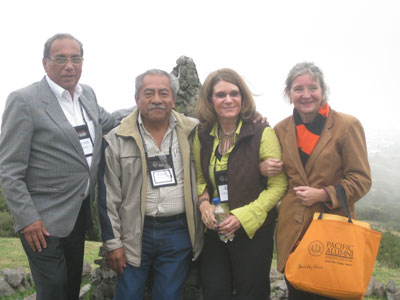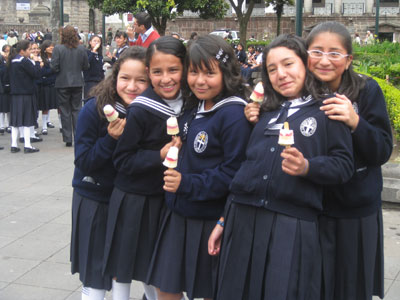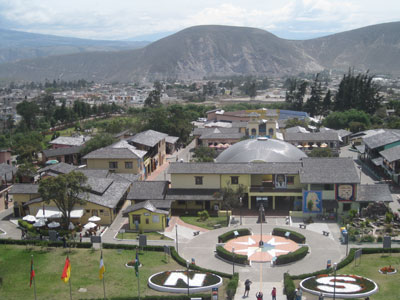Exploring Quito
by Kimberly Edwards, Sacramento, CA
To join college classmates in Ecuador in October ’10, I booked a Los Angeles-to-Quito flight online with the Costa Rican airline Lacsa, one of the five airlines that make up TACA. While their telephone and Internet boarding pass systems didn’t impress me, the flights ran like clockwork.
Quito
After my arrival in Quito, I cleared Immigration quickly; no visa is required if visiting for fewer than 90 days. The Hotel Quito (phone +593 2254 4600) shuttle awaited ($8, though a regular cab cost $5).
My hotel room offered a magnificent view of the pool, manicured gardens and picturesque mountains draped across populated flatlands. Rooms situated on the street side were not as quiet.
Our group’s room rates, negotiated by our Ecuadorian classmates, were $70 each per night, including a diverse breakfast buffet. The hotel staff spoke English.
Nestled among mountain peaks, Quito dishes a vibrant lifestyle interwoven with a rich, indigenous Incan and Spanish past, nuanced with French, Italian, German and other cultural influences. A vast labyrinth of colonial buildings, plazas and churches earned the city one of UNESCO’s first World Heritage Site designations.
Fabian C. Borrero, son of one of my classmates and author of two photo-filled books on Ecuador’s amazing diversity, noted, “If you would draw an imaginary circle around Quito with a radius of 120 kilometers, you would find inside that circle the rain forest, cloud forest, beautiful Andean lakes, several volcanoes including snow-peaked Cotopaxi, Antisana and Cayambe (the only mountain in the world right on the Equator holding 0 degrees in temperature and snowcapped year-round).”
Area attractions
Our tour guide, Fabián Amores, took our group on several tours over four days. He displayed a great deal of knowledge of historical details. In good English, he made us feel comfortable in his country. There wasn’t anything we couldn’t ask.
You can find Fabian through Chakana Tours (phone 593 2 2871596 or e-mail info@chakanaecuador.com), the company we used to book our excursions. Day-long tours range from $50 to $60.
The following are among the highlights of my visit to Quito.
The Mitad del Mundo* (Middle of the World) attraction offers a sweeping view of the area. A colonial-style town, complete with a main square, church, post office, ice cream shop, restaurants and gift shops, leads to a three-dimensional rendition of old Quito animated with church bells, a crowing rooster and artificial lighting depicting sunset and sunrise.
Many locals visit on weekends, so I’d recommend going during the week. Admission to the Middle of the World (website in Spanish only), including entry to the maquette, cost $3 per person.
Quito’s Centro Histórico features exquisite colonial architecture that has been carefully restored. Modern housing and businesses intermingle with 450-year-old buildings along narrow roads winding up and downhill. Churches, convents and monasteries stand as examples of the Baroque school of Quito, a mix of Spanish, Italian, Moorish, Flemish and indigenous design.
On Mondays, Ecuador’s president makes an appearance on the balcony of the Presidential Palace, drawing a cross-section of the local community into the surrounding gardens. During our visit, soldiers marched, whirled flags and played instruments. Onlookers included young people, indigenous women with babies wrapped on their backs, and working people anxious to get a glimpse of their popular president.
The Museo del Banco Central (National Museum of the Central Bank) houses a collection of gold masks, paintings, utensils and three-dimensional models of life in Ecuador. Artifacts date back to 11000 BC. The collection is huge. I was taken aback by the clay bottles shaped like animals that, when blown, each make the sound of the species it represents.
Every display is carefully marked in Spanish and English, and guides are available to assist English speakers. Plan to spend several hours there.
Outside Quito
A two-hour shuttle ride ($95 including breakfast and lunch) delivered us to the rustic complex of the Bellavista Cloud Forest Reserve, where we hiked and looked for orchids. This is a good place for sighting some of Ecuador’s 1,600 bird species.
I enjoyed the hummingbirds (from among the country’s more than 130 variations) eating from their feeders. Because the sun was out, the toucans perched high in the trees, so we didn’t see them.
The day was relaxing, though the food was unremarkable. Hotel rooms can be rented there, but, for me, a day was enough. My friends enjoyed the hiking, which was not terribly arduous.
The charming village of Cotacachi, two hours north of Quito, is known for its participatory democratic process and high literacy rate. The village offers colorful textiles for purchase, and serene streets are filled with shops offering leather goods at good rates. If time permits, “work” the stores methodically on both sides of the road in search of the best deals for boots, bags, wallets and jackets. If I had had more time, I would have returned for more leather items.
While I didn’t visit, I heard from others that Cochasquí, located 45 minutes north of Quito, was worth seeing. Made up of 15 pyramids and numerous funeral knolls, the complex maintains a llama reserve, a botanical garden specializing in Andean plants with medicinal purposes and a small but informative archaeological museum.
The town of Cayambe, about 90 minutes from Quito, is famous for ladyfinger-size, buttery and flaky biscuits, eaten with a cheese similar to mozzarella. The family-owned business Fabrica de Bizcochos San Pedro makes 10,000 biscuits each day. You can walk in and see them made. Everything is done by hand, and the biscuits are baked in the traditional wood oven.
Situated on the rim of a volcano crater, El Cráter Restaurant (phone +593 2 2398132) offers a scenic, 360-degree view of Quito and the fog that swirls in around early afternoon. I enjoyed fried pork, potato soup, potato patties and figs with cheese for about $20. Everything served was enjoyable and not too spicy, for my palate.
Dinner at Pim’s El Panecillo comes with the spectacular glow of a gorgeous city view from atop this hill overlooking the Old City. By Quito standards, this restaurant is on the expensive side (dinner can be had for under $30 per person), but the panoramic view makes the visit worth it.
Not only is the restaurant mentioned on numerous websites, the locale came recommended by local Ecuadorians — a valid endorsement, in my book.
Correction (Published July '11, pg. 53) — Regarding the photo captioned, “…classmates standing on either side of the equator at Mitad del Mundo,” Fred Koehler of Orange, CA, and Derald Nye of Corona de Tucson, AZ, wrote in to point out that that monument in Ecuador is not at 0°0°0° latitude but actually stands about 240 meters south of the equator, as any visitor with a GPS device will attest.
In fact, the line at the monument actually marks the supposed location of the equator as established by Charles-Marie la Condamine and his team on their Geodesic Mission to Ecuador in 1736-1744. — Editor




